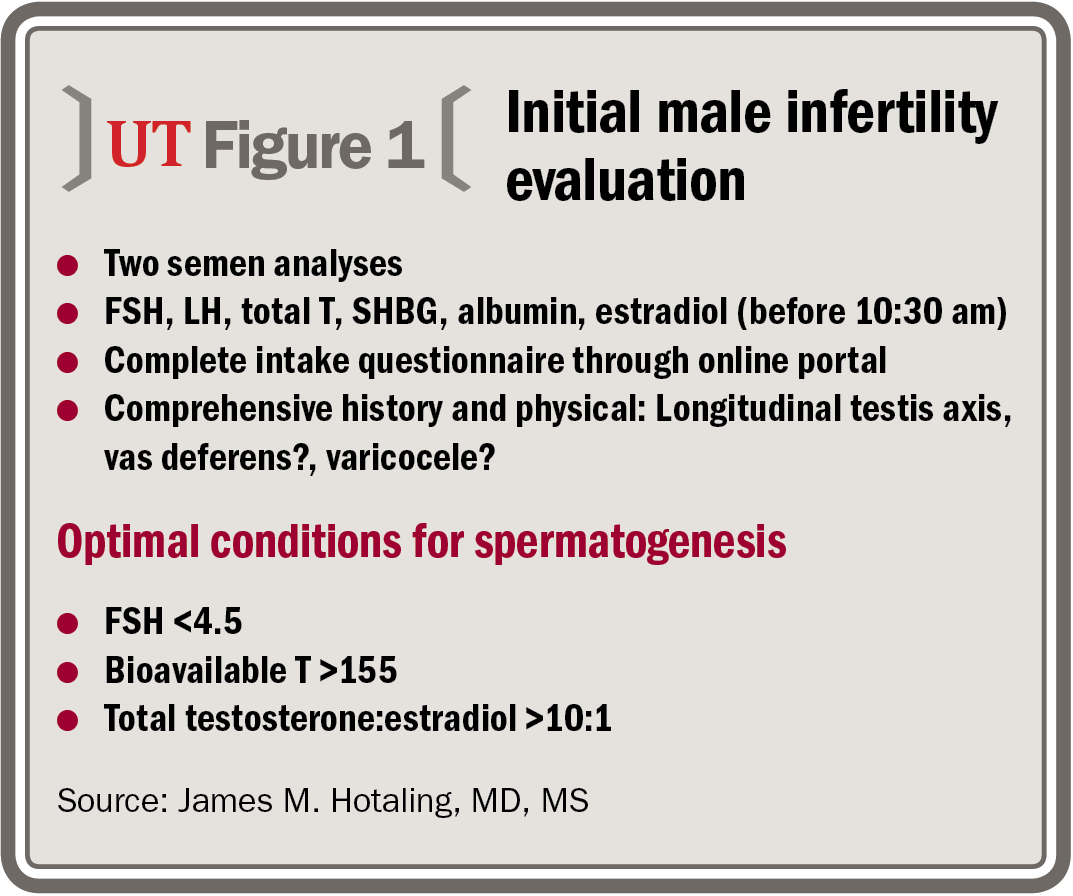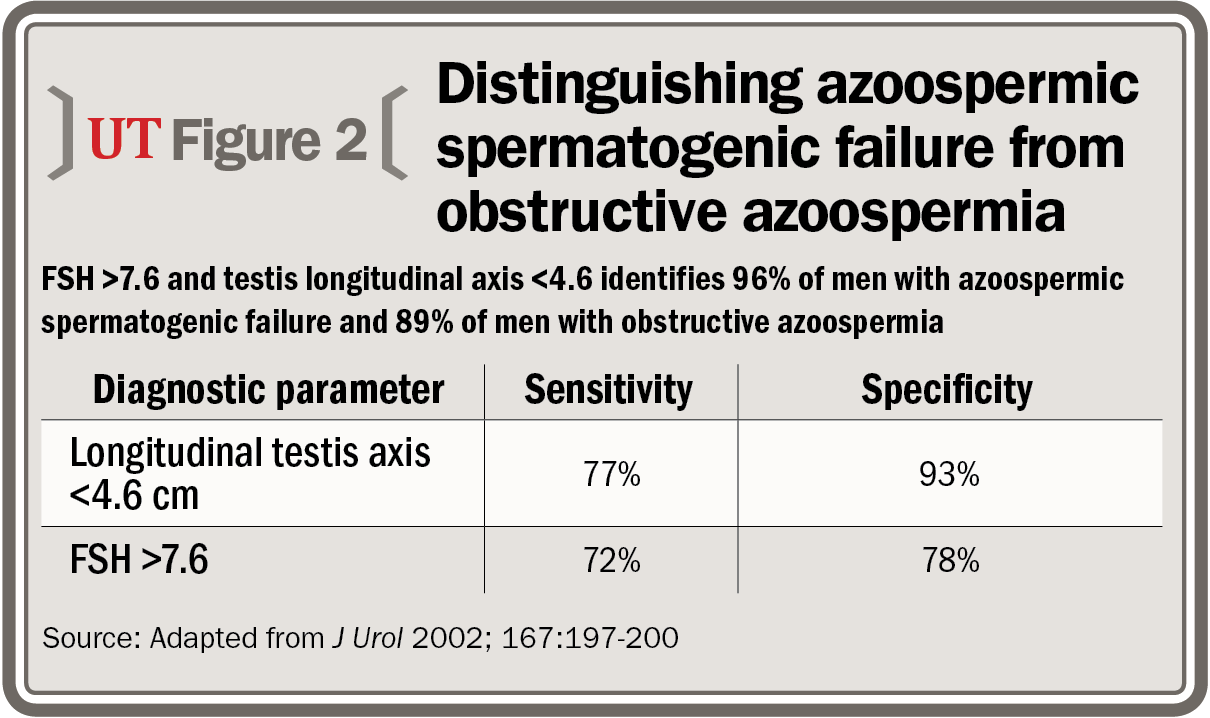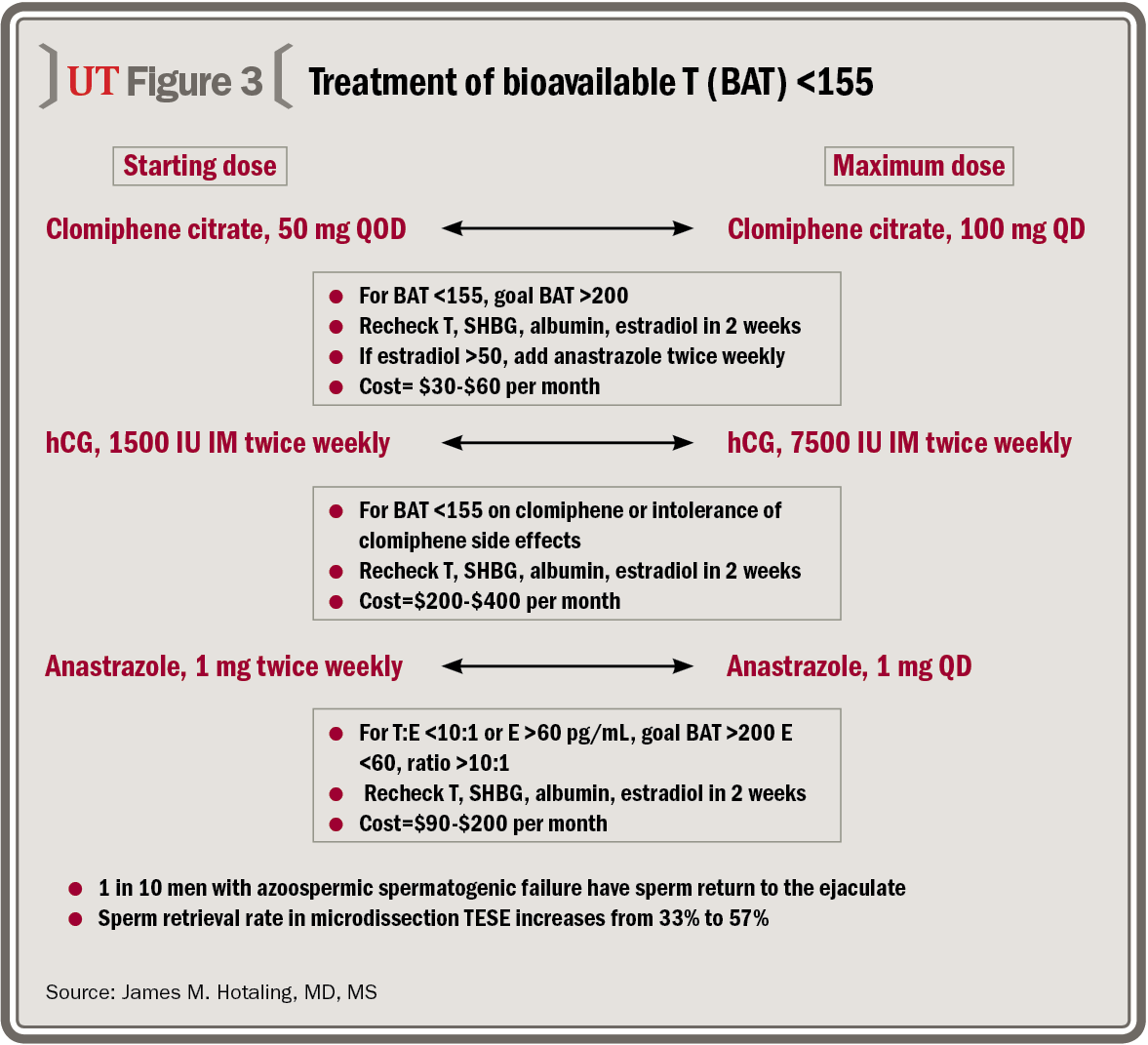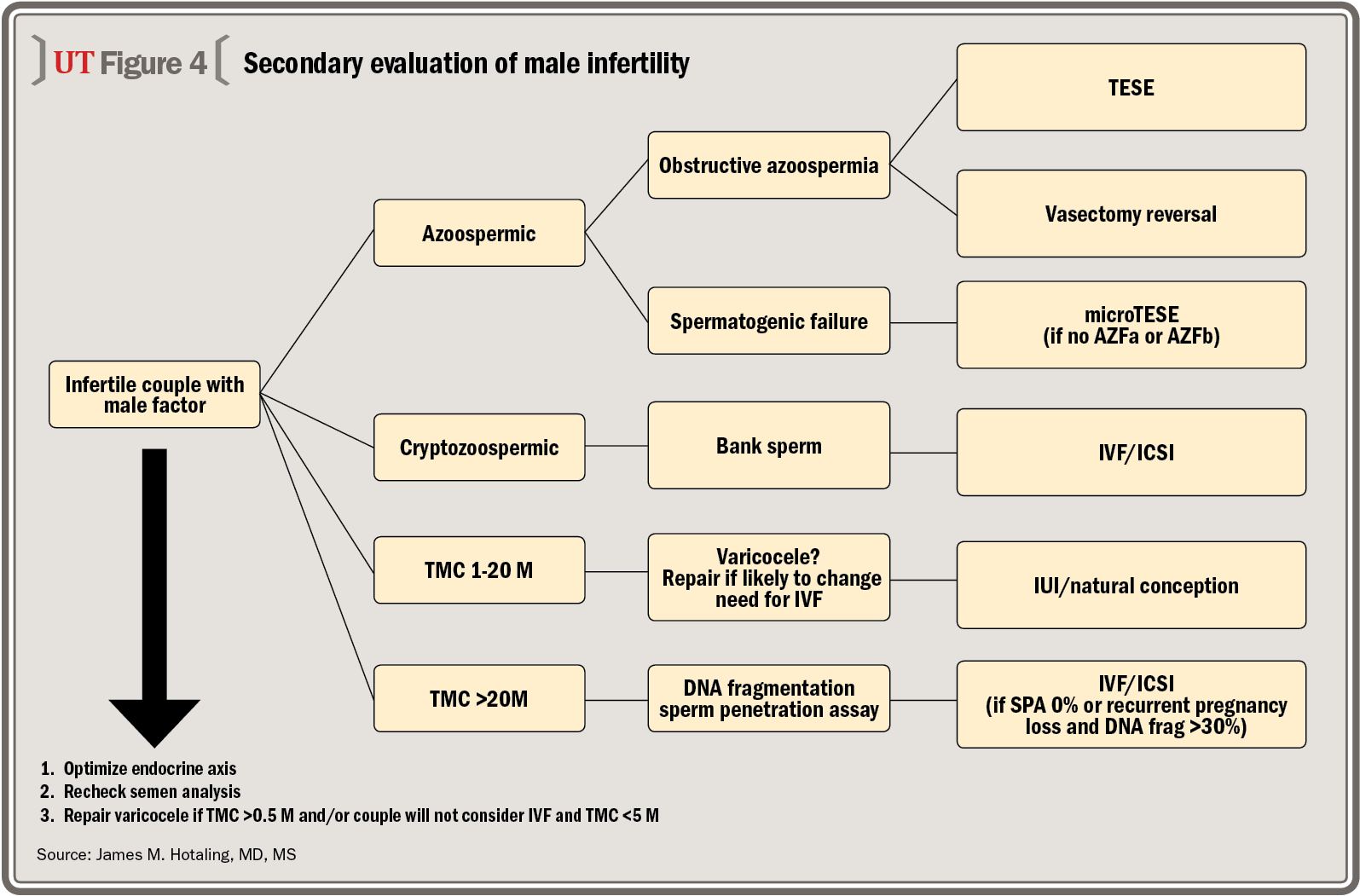Article
Cost-effective workup of the infertile male patient
In this article, James M. Hotaling, MD, MS, outlines the elements that comprise a cost-effective workup of the infertile male patient.


Male infertility is a devastating and frequent condition that, in most instances, remains outside the domain of insurance coverage.
READ: Workplace exertion among factors linked to male infertility
Infertility, as defined by the inability to conceive after 12 months of regular unprotected intercourse, impacts 15% to 20% of all couples, with male factor being responsible in 50% (Int J Androl 2006; 29:2-11; Hum Reprod 1991; 6:811-6; Hum Reprod 2001; 16:481-6). Male infertility is significantly more costly to treat than female infertility and, even in states where coverage is mandated for female infertility, it is unlikely to be covered (Urol Clin North Am 2014; 41:205-11; J Urol 2005; 174:1926-31). Finally, all of this is happening in a cost-constrained medical system with a declining number of urologists.
Assessment of the infertile male is also hindered by the inability of bulk seminal parameters to adequately predict pregnancy and live birth rates in the vast majority of men. Although a total motile count (TMC) of less than 5 million does predict a poor chance of success with intrauterine insemination (IUI) and chance of natural pregnancy increases proportionately with sperm TMC of one sperm to approximately 20 million, the only finding that completely precludes natural conception is azoospermia (Hum Reprod March 8, 2015 [epub ahead of print]).
Male infertility is also the only area in medicine, along with female infertility, where the unit of treatment is the couple and not an individual. This makes effective and timely communication between reproductive endocrinologists and urologists vital in delivering high-value, cost-effective care for infertile men and their partners. Further, the presence and severity of female infertility factors will significantly impact the decision for optimal treatment of male infertility.
In this article, I outline the elements that comprise a cost-effective workup of the infertile male patient.
NEXT: Initial evaluation of male infertility
More on Men's Health
Alternatives to T therapy: Lessons from male infertility
Men's health: How urology and primary care can work together
How ‘chemoimmunotherapy’ may help destroy advanced PCa
Initial evaluation of male infertility
The cornerstone of a cost-effective male infertility evaluation is a thorough history and physical. We use a standardized questionnaire that is built into an electronic database, populated by patients through a web portal prior to their arrival (visit http://healthcare.utah.edu/andrology/fees.php and click “Male Infertility Questionnaire”). This form, which is an adaptation of an intake form developed by Craig Niederberger and another by Keith Jarvi, is part of an ongoing project to develop a cloud-based male infertility web portal by our group, Pravin Rao, Mike Eisenberg, Keith Jarvi, and others. This intake form covers all aspects of male infertility and provides a baseline analysis of female infertility as well. It auto-populates a clinic note prior to the visit.

Due to the limited ability of electronic medical record systems such as EPIC to support the care of infertile patients, this system has saved us a significant amount of time and allows us to ensure a comprehensive evaluation of male infertility in a timely fashion. This system also allows us to identify simple lifestyle changes that can improve fertility, such as weight loss, reducing exposure to wet heat or spermatotoxic chemicals or medications, quitting smoking, and discontinuing use of cocaine or marijuana. As part of this form, we also obtain an androgen deficiency of the aging male (ADAM) form as well as a Sexual Health Inventory for Men (SHIM) form to assess for hypogonadal symptoms and erectile dysfunction.
ALSO SEE: Post-RP radiation therapy on decline in U.S.
Of course, a comprehensive evaluation also includes treating sexual dysfunction, assessing coital technique and frequency, time of vasectomy (if performed), identifying and treating any medical conditions that are contributing to male infertility, and ensuring that a man has a primary care provider. Additionally, we typically refer the female partners of our patients to a reproductive endocrinologist if they have not already seen one. Pyospermia, if present, is treated with a 4-week course of a quinolone and resolution is confirmed with a semen analysis.
Endocrine evaluation. Due to the fact that >40% of our patients come from over 100 miles away, we have elected to have patients obtain a standardized endocrine workup and at least one semen analysis (preferably two) prior to their arrival (figure 1). The importance of obtaining these two semen analyses from a high-quality reference lab that can reliably confirm azoospermia or cryptozoospermia after examining a centrifuged pellet cannot be overstated.

We have also found that many men have normal bulk seminal parameters, hypoandrogenism, and primary infertility (Urology Feb. 28, 2015 [epub ahead of print]). We use a calculated bioavailable testosterone with a threshold of >155 ng/dL as optimal for spermatogenesis (testosterone, SHBG, albumin, calculated per the International Society for the Study of the Aging Male website [http://www.issam.ch/freetesto.htm]) (J Clin Endocrinol Metab 1999; 84:3666-72). Further, we evaluate estradiol to ensure that the testosterone:estradiol ratio is greater than 10:1. If the testosterone is low and labs indicate hypogonadotropic hypogonadism, we will also obtain a prolactin.
READ: Biomarkers yet to fully justify claimed clinical utility
GU exam. In addition to this endocrine evaluation, we also complete a thorough male genitourinary exam and document the secondary male sexual characteristics, longitudinal testis axis, and presence of varicoceles and vas deferens. Our rationale for completing this endocrine evaluation in everyone is that we often find treatable hypoandrogenism that can enable natural pregnancy or IUI through medical therapy alone. These treatments are far less expensive than surgical interventions or assisted reproductive technologies (ART).
Per the American Society for Reproductive Medicine and AUA guidelines, we also obtain genetic testing consisting of a Y chromosome microdeletion and karyotype on all men with sperm concentration less than 5 M/mL and obtain a cystic fibrosis transmembrane conductance regulator test on any man without palpable vas deferens (https://www.auanet.org/education/guidelines/male-infertility-d.cfm). Our other rationale for obtaining the endocrine evaluation on all men is to reliably differentiate obstructive azoospermia from spermatogenic failure (figure 2).
NEXT: Initial approach to the man with primary infertility
Our initial approach to the man with primary infertility is outlined in figure 3. Although some would advocate only treating men who are hypoandrogenic and have an abnormal semen analysis, given the variability of semen parameters and the inability of semen analyses to reliably predict pregnancy, we treat most men with hypoandrogenism and infertility.

Once the patient is on a stable dose of medication, we repeat a hematocrit, testosterone, and PSA every 3 months for a year and then annually for the duration of medical therapy. Clomiphene is generally well tolerated, but some patients do not respond or have a paradoxical response (~6%), hence the need for rechecking labs 2 weeks after each change in dosing. We have found that endocrine manipulation in men is a cost-effective first step in management along with lifestyle modification. We repeat a semen analysis 3 months after any intervention to assess the impact of our intervention. Additionally, we email a copy of the note in a HIPAA-secure fashion to the referring reproductive endocrinologist the day of referral to ensure timely evaluation.
RELATED: BPH technique efficacious even in severe obstruction
We have seen that approximately 3% to 10% of hypoandrogenic men with azoospermic spermatogenic failure will have sperm return to their ejaculate after normalization of their male endocrine axis (BJU Int 2013; 111:E110-4). Further, this has been found to significantly improve sperm retrieval rates, which will further drive down costs for infertile couples. Although the absolute chance of significant motile sperm returning to the ejaculate is low, we have had patients who have gone from azoospermic to TMCs of >100 M and saved tens of thousands of dollars in microdissection testicular sperm extraction (TESE) and ART costs. Further, they have avoided the risk of surgery.
Secondary evaluation
After completing the physical exam, history, endocrine evaluation, and semen analyses, we use an algorithm to stratify treatment options based on the couples’ goals and TMC (figure 4). Further, we always recommend cryopreserving sperm in order to allow multiple attempts at in vitro fertilization/intracytoplasmic sperm injection from one procedure. We typically obtain six vials of sperm from one TESE procedure from a man with obstructive azoospermia and one to four from a man with azoospermic spermatogenic failure. For men with obstructive azoospermia, we offer TESE or microsurgical reconstruction.

Our management of varicocele is based on the potential of treatment to impact the ultimate therapeutic course of the patient. Recent data have indicated that up to 45% of the partners of men who undergo varicoelectomy may become pregnant within 1 year of follow-up. This same study also found that only preoperative sperm concentration was an independent predictor of spontaneous pregnancy, leading the authors to conclude that patients with high initial sperm concentration may benefit from varicocelectomy (Fertil Steril 2015; 103:635-9). Despite these recent data, we base our decision of whether to surgically repair a varicocele on four factors:
- Is the varicocele at least Grade 2?
- Are there female factors that would mandate IVF?
- Would the couple consider IVF?
- Is treatment of the varicocele likely to enable IUI or natural pregnancy?
Part of the difficulty in providing cost-effective care of the infertile male is the inability of bulk semen parameters to predict pregnancy. For this reason, in couples with normozoospermia and unexplained infertility or recurrent pregnancy loss, we obtain a DNA fragmentation assay and a sperm penetration assay. If there is less than 5% sperm penetration or a DNA fragmentation is >35%, we typically recommend IVF/ICSI.
The future
One fascinating vehicle for providing cost-effective care of infertile couples is an integrated practice unit, or IPU. The concept of an IPU was developed by Michael Porter, PhD, MBA, of Harvard Business School and Thomas Lee, MD, MSc, of the Harvard T.H. Chan School of Public Health, Boston. The IPU “is organized around a medical condition or a set of closely related conditions (or around defined patient segments for primary care),” in which “care is delivered by a dedicated, multidisciplinary team of clinicians who devote a significant portion of their time to the medical condition,” according to an October 2013 Harvard Business Review article by Dr. Porter and Dr. Lee.
The IPU is designed to increase value for patients by improving quality and service while driving down costs. We are in the process of creating such an IPU at the University of Utah. Essentially, all services for reproductive couples, including urology, pharmacy, and reproductive endocrinology, share a financial bottom line and organizational structure so that they can optimize care for infertile couples. We are early in this process, but have found that it has great potential to optimize cost-effective care for these couples.
You might also like:
Managing bone health in men with metastatic prostate cancer
Aspirin raises bleeding risk in partial nephrectomy
Study supports BPH laser’s use in high-risk men
Subscribe to Urology Times to get monthly news from the leading news source for urologists.
Newsletter
Stay current with the latest urology news and practice-changing insights — sign up now for the essential updates every urologist needs.













